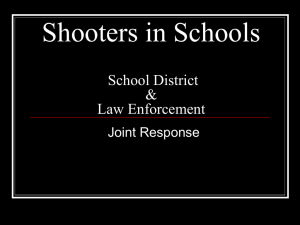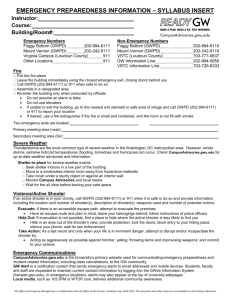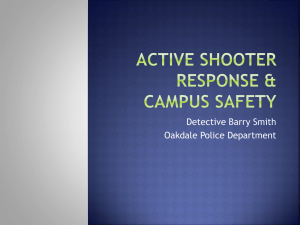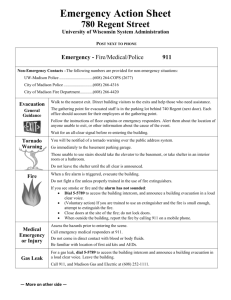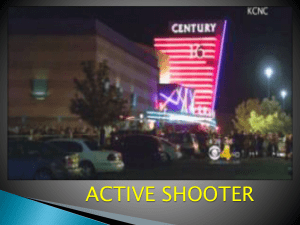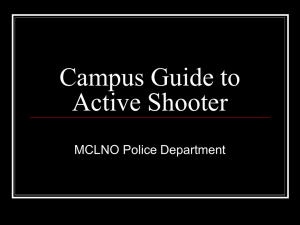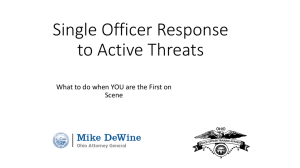First Aid
advertisement
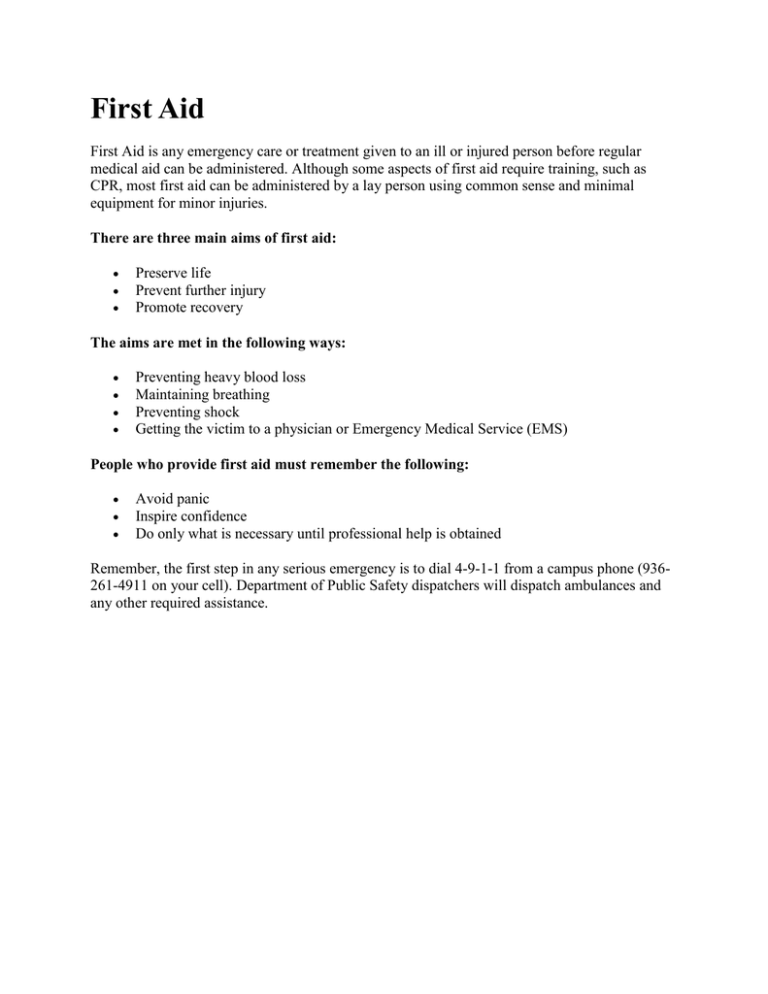
First Aid First Aid is any emergency care or treatment given to an ill or injured person before regular medical aid can be administered. Although some aspects of first aid require training, such as CPR, most first aid can be administered by a lay person using common sense and minimal equipment for minor injuries. There are three main aims of first aid: Preserve life Prevent further injury Promote recovery The aims are met in the following ways: Preventing heavy blood loss Maintaining breathing Preventing shock Getting the victim to a physician or Emergency Medical Service (EMS) People who provide first aid must remember the following: Avoid panic Inspire confidence Do only what is necessary until professional help is obtained Remember, the first step in any serious emergency is to dial 4-9-1-1 from a campus phone (936261-4911 on your cell). Department of Public Safety dispatchers will dispatch ambulances and any other required assistance. Severe Weather Severe weather is defined as any aspect of the weather which can pose a threat to life and property. Local Weather Conditions Local media outlets will provide updates and information on severe weather. Prairie View A&M officials will notify local outlets regarding closings or return-to-work situations. Television (cable/satellite channels may vary) o KPRC, channel 2 o KHOU, channel 11 o KTRK, channel 13 Radio o KPVU, 91.3 FM o KTRH, 740 AM Online o National Weather Service o PVAMU Emergency Notifications o Channel 2 Weather o Channel 11 Weather o ABC Channel 13 Local Weather If severe weather threatens you should: Follow instructions as provided by your Department/University Listen to radio and television for weather updates Check with media for return to work status Fire A major fire occurring on the Prairie View A&M campus could involve areas where multipleoccupancy residences and/or facilities are clustered closely together, increasing the possibility of rapid spread of a structural fire. Thus, it is very important for the campus community to recognize fire hazards, practice building evacuations, and know what to do when the fire alarm sounds. The causes of fires usually involve one of the following: Criminal acts (arson) Building and Residential accidents (faulty insulation or connections, improper use of electrical appliances, grease fires, smoking in bed, baseboard heaters, etc.) Industrial Accidents (hazardous materials incidents, explosions, transportation accidents) In Preparation for a Fire: Plan and Practice an escape route Post emergency numbers near telephones Get training from Environmental Health and Safety on using fire extinguishers Do not store combustible materials in closed areas or near a heat source Extension cords can be dangerous. Never run them under carpets, or anywhere they can be pinched under or behind furniture. Avoid overloading electrical sockets and plugging extension cords together Keep all electrical appliances away from anything that can catch fire. Remember to always turn them off at the end of the day Pay attention to housekeeping issues. Do not clutter exits, stairways, and storage areas with waste paper, empty boxes, and other fire hazards If there is a fire inside a building: Activate a fire alarm or pull station Call 4-911 from a campus phone (936-261-4911 from cell) and provide your name, building name, address, floor, location, and related information Evacuate the building using Building Evacuation instructions Building Evacuation—When the building fire alarms sound: Immediately evacuate using building emergency plan procedures Walk to nearest exit/stairwell (close doors behind you) Do not use the elevators Proceed to the designated gathering area outside the building and report to your Floor Proctor (for a headcount) Do not re-enter the building until cleared by authorized personnel Assist with the evacuation of individuals with specials needs If the fire is outside a building: Call 4-911 from a campus phone (936-261-4911 from cell) and give your name, building name, address, floor, location, and related information Do NOT activate the building fire alarm system You can use a portable fire extinguisher if: You are properly trained (you have had hands-on training) It is a small, contained fire (e.g. wastebasket) You can extinguish it within 12 seconds (evacuate if it takes longer) If you are unable to leave the building, you should create an area of refuge: Seal the room. Use wet cloth to stuff around cracks in floors and seal up vents to protect against smoke. Do not break windows. Flames and smoke can come back in from the outside. If you need air, open the window a crack. Stay low under smoke. The freshest air is near the floor. Keep a wet cloth over your nose and mouth, breath through your nose only. Signal for help. Call 4-911 from a campus phone (936-261-4911 from cell) or hang something in the window After a fire: Give first aid where appropriate. Seriously injured or burned victims should be transported to professional medical help immediately Stay out of damaged buildings. Return to buildings when local fire authorities say it is safe Look for structural damage Discard food that has been to heat, smoke, or soot Don't discard damaged goods until after an inventory has been taken. Save receipts for money relating to fire loss Personal Safety While Prairie View A&M University has done as much as possible to make this a safe campus, safety ultimately becomes a personal matter. How safe you are depends on your preparation and how much attention you pay to your surroundings. The university does, however, offer several programs to help keep you safe. Active Shooter Clearly, response to an active shooter is one of the most dynamic situations that any department will ever face. It will result in immediate deployment of law enforcement resources to stop the shooting and mitigate harm to innocent victims. Prior to the arrival of the police personnel, how you respond to an active shooter will be dictated by the specific circumstances of the encounter, keeping in mind there could be more than one shooter involved in the same situation. If you find yourself in an active shooter situation, try to remain as calm as possible and use these suggested actions to help you plan a strategy for survival. Keep in mind, the entire area is still a crime scene. Active Shooter Outside Building Go to a room that can be locked or barricaded by using available material. Close the window blinds, turn off the lights and get everyone down of the floor so that no one is visible from outside the room. Spread out and seek concealment behind walls, desks, file cabinets etc. Have someone call 4-9-1-1 from campus phone (936-261-4911 from a cell telephone. Be aware that the 4-9-1-1 system will most likely be overwhelmed. When you reach the dispatcher, describe the situation and give your name and location; remain in place until the police give the "All Clear." Unfamiliar voices may be the shooter attempting to lure victims from their safe space; do not respond to any voice commands until you can verify with certainty that they are being issued by a police officer. Active Shooter Inside Building If possible, secure the room you are in by either locking or barricading the door using available material and follow the same procedures described above. If you cannot secure the room, determine if there is a nearby location that you are able to reach safely and then secure or if you can safely exit the building. Active Shooter Inside Room If the active shooter enters your office or classroom, there are no set procedures. The decision to flee or seek shelter inside the room can only be made by you and is dependent upon the circumstances. Try to remain calm, it will aid you in decision making. Call 4- 9-1-1 from campus phone if possible (936-261-4911 from cell), and alert police to the shooter's location. If you can't speak, leave the line open so the dispatcher can hear what is taking place. Usually the location of a caller can be determined without speaking. If there is absolutely no opportunity of escape or concealment and the shooter is not actively firing on victims it might be possible to negotiate with the shooter. If the shooter has fired on victims you are faced with a life or death situation; only you can consider your next course of action. After all other options have been exhausted, you may be faced with the decision to overpower the shooter with force by whatever means necessary. Active Shooter Leaves Room If the shooter leaves the area and the environment appears safe, proceed immediately to a safer place. Do not touch anything that was in the area of the shooter because of the possibility of explosives being left and the destruction of crucial evidence. What You Should Do Make sure you have an escape route in mind. Do not attempt to carry anything in your hands while fleeing; move quickly Keep your hands visible, and follow instructions given by any police officers you may encounter. If you know where the shooter is located, tell the officers. Remain at the designated assembly point until you have been released. Do not drive off campus until told it is safe to do so by police. Do not try to move any injured people; leave them where they are and notify authorities of their location as soon as possible. What You Should Expect Responding police officers are trained in active shooter response to proceed immediately to the area where the shots were last heard; their purpose is to stop the shooting as quickly as possible. The first officers to arrive will not stop to aid injured victims; rescue teams composed of other officers will follow the first team into secured areas and remove injured persons. The first officers on the scene will likely be from the University Police Department. Depending on the situation, they may be joined by officers from different agencies and dressed in different uniforms. There may even be some officers in civilian clothes wearing an external bulletproof vest. Some officers may be dressed in Kevlar helmets and other tactical equipment. They may be armed with rifles, shotguns or handguns. Do as the officers tell you and do not be afraid of them. Bomb Threat Bombs can be constructed to look like anything and can be placed or delivered in any number of ways. The probability of finding a bomb that looks like the stereotypical bomb is almost nonexistent. The only common denominator that exits is that they are all designed and intended to explode. A bomb threat is generally defined as a verbal threat to detonate an explosive or incendiary device to cause property damage or injuries, whether or not such a device actually exists. There are two main reasons someone may call with a bomb threat: The person knows of an explosive device that is in place, and wants to minimize injuries The person wants to create an environment of panic/confusion or to interrupt normal office/building functions The latter reason is the most frequently encountered, especially in school settings (and particularly when major exams are scheduled or projects due.) Unfortunately, there is often no way to tell which is the motivation of the caller until after a thorough inspections of the building is conducted. This means that there will always need to be a response to the threat by emergency services personnel (police, fire, and medical.) If you receive a call: Immediately after the call is terminated, hang-up, obtain dial tone, dial #91, then hang-up (called a trace/trap procedure) Call 4-911 from a campus phone (936-261-4911 from cell) and the dispatcher will notify University Police Document the conversation using the Bomb Threat Checklist Notify the department head/building proctor Meet with and assist University Police personnel As directed by University Police, help locate/identify suspicious items Evacuate building, as directed (use of public address system preferred or use building fire alarm system) Do not re-enter building until cleared by authorized personnel
